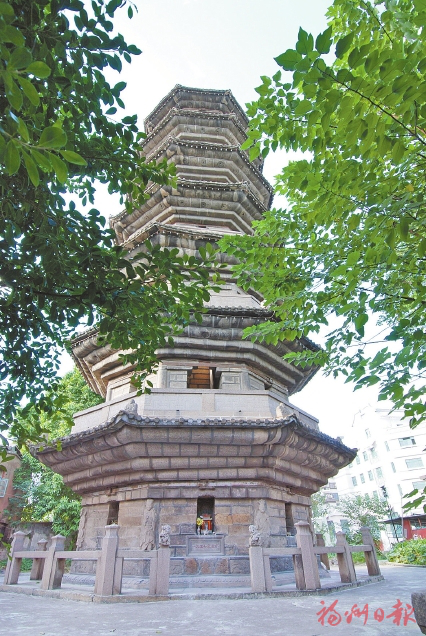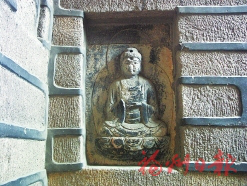Black Pagoda: The Oldest Stone Pagoda in Fujian Province
2020-04-08 09:41:21
Black Pagoda: The Oldest Stone Pagoda in Fujian Province
Reported by Wu Hui
2020.04.08 April 8, 2020

The Black Pagoda is the oldest large-scale stone pagoda preserved in Fujian Province. (Photo courtesy of Fuzhou Municipal Department of Cultural Heritage)
FUZHOU, April 8 (Fuzhou Daily) – There are two ancient pagodas towering in the heart of Fuzhou City: the Black Pagoda and the White Pagoda. The Black Pagoda is officially named the Solid Pagoda of Chongmiao Baosheng, and the White Pagoda officially named the Treasure Pagoda of Bao’en Dingguang. As iconic landmarks of the ancient city of Fuzhou, they compose the ancient city’s basic layout of “three hills, two pagodas and one street,” together with Wushan Hill, Yushan Hill, Pingshan Hill, the Three Lanes and Seven Alleys, and the Nanhou Street.
Discovery records
The Solid Pagoda of Chongmiao Baosheng stands at the east foot of Wushan Hill. The pagoda laid with huge granite stones features black exterior, hence its nickname “Black Pagoda.” The pavilion-style pagoda has seven stories and features an octagonal layout, with a height of 34.74 meters. Its foundation is a layer of stone blocks. Its stepped base has five stairs, each being 1.88 meters tall. The first floor is encircled by balustrades, with a door opening to the east. A stone stairway spirals upwards inside. Starting from the second floor, each floor has two doors opposite to each other, as well as a flat seat and balustrade. Moreover, each floor features overlapped upturned eaves and niches on the exterior wall. The niches are inlaid with a total of 46 black shale relief sculptures of the Buddha. The pagoda is inlaid with a stone tablet bearing its name written in kaishu (regular script) and inscriptions about its construction. As the oldest large-scale stone pagoda preserved in Fujian Province, it is a precious relic to study the history of the Min kingdom during the Five Dynasties and Ten Kingdoms period (907-960) as well as the religion, sculpture and art of that time.
Historical origin
Hidden in the Black Pagoda is the oldest stele of Fuzhou
Narrator: Chen Yubiao, director of the Division of Museum and Cultural Heritage Security of Fuzhou Municipal Department of Culture and Tourism
In 799, the 15th year of the Zhenyuan reign of the Tang Dynasty (618-907), Liu Mian, then surveillance commissioner of Fujian, built a pagoda to celebrate the birthday of Emperor Dezong Li Shi, which was named Zhenyuan Wugou Jingguang (literally, “Immaculate Pure Light”) Pagoda. In 879, the first year of the Qianfu reign of the Tang Dynasty, the pagoda was destroyed in war after the uprising of Huang Chao. The pagoda still preserves a stone tablet carrying the “Associative Foreword for the Zhenyuan Wugou Jingguang Pagoda Constructed upon the Emperor’s Decree” written by Yu Chengxuan, a high-ranking official in the Tang Dynasty. It is the oldest existing stele in Fuzhou.
In 941, the sixth year of the Tianyou reign of the Later Jin Dynasty (936-947), Wang Yanxi, the seventh son of Prince of Min Wang Shenzhi, proclaimed himself emperor and founded the Min Kingdom. He constructed the Solid Pagoda of Chongmiao Baosheng on the site of the former Zhenyuan Wugou Jingguang Pagoda. The pagoda was planned to have nine floors. In 944, the ninth year of the Tianyou reign, Wang Yanxi was killed in a coup launched by his subordinates. By the time, only seven floors of the pagoda were completed.
How did ancient constructors build such a high stone pagoda? No historical records gave answer to this question. A theory circulating in folk tales is known as “Piling earth into a hill to build a pagoda.” According to the theory, constructors piled up earth and gravels beside the pagoda foundation to form a slope and then put huge stone blocks on a slipway comprised of round logs, along which people dragged and pulled them to the top of the slope. In this way, the slope was constantly extended as the pagoda got higher. After the completion of the pagoda, the slope was moved away.
In 1621, the first year of the Tianqi reign of the Ming Dynasty (1368-1644), the Black Pagoda underwent a major overhaul, and the sculptures of the Eight Buddhist Protectors were inlaid in the first floor of the pagoda. In 1649, the sixth year during the reign of Emperor Shunzhi of the Qing Dynasty, when the Stone Pagoda Temple was reconstructed, the Black Pagoda was renovated again. During its reconstruction in 1698 (the 35th year during the reign of Emperor Kangxi), the spire of the Black Pagoda was recast, which was called “Eight-Treasure Copper Gourd-shaped Summit.” In 1821, the first year during the reign of Emperor Daoguang, several stone components of the Black Pagoda were blown down by the wind, and the body of the pagoda began to incline eastwards. In 1838, the 18th year during the reign of Emperor Daoguang, some stones dropped in a lightning strike. In the early days of the Republic of China period (1912-1949), the stone balustrade of the pagoda collapsed.

A relief sculpture of the Buddha on the Black Pagoda. (Photo courtesy of Fuzhou Municipal Department of Cultural Heritage)
Protection and inheritance
From a major monument protected at the provincial level to one protected at the national level
In 1957, the pagoda was reinforced by infusing cement grout into stone cracks to prevent it from further inclining. Later, all floors of the pagoda were fastened with steel bars to prevent eroded stones from falling. Moreover, a lightning rod was installed on the top of the pagoda to guard against lightning strikes. An archaic pavilion was constructed to the south of the pagoda to shelter the stele carrying the “Associative Foreword for the Zhenyuan Wugou Jingguang Pagoda Constructed upon the Emperor’s Decree.” In May 1961, the Black Pagoda was declared a major monument protected at the provincial level. In December 1963, a stele for protected cultural heritage was erected. On June 25, 2001, the Black Pagoda was listed by the State Council among the fifth batch of major monuments protected at the national level.
In order to better protect and display the Black Pagoda, the Fuzhou Municipal Department of Cultural Heritage took over its administration in the 1980s. In 1996, for the purpose of protecting the cultural relic, displaying the hill and the pagoda, and improving the living environment of local residents, Fuzhou began to demolish dilapidated residences surrounding the pagoda, and organized experts several times to formulate design plans for the locality.
In 1999, the Fuzhou Municipal Department of Cultural Heritage launched a project for overall environmental renovation of the area nearby the Black Pagoda. Considering that the pagoda already became inclined, in February 2000, the Fuzhou Municipal Department of Cultural Heritage entrusted Fujian Chengjia Geological Engineering Investigation Institute to conduct a geological survey for the Black Pagoda, and entrusted Fuzhou Architectural Design Institute to monitor the inclining conditions of the pagoda on the basis of fixed time and fixed location. In September of the same year, the Fuzhou Municipal Department of Cultural Heritage commissioned Tongji Architectural Design (Group) Co., Ltd. to formulate the “Plan for the Conservation and Renovation of the Solid Pagoda of Chongmiao Baosheng in Fuzhou.” In April 2001, it entrusted Fujian Academy of Building Research Co., Ltd. to formulate the “Assessment of the Current Conditions of the Black Pagoda and Its Protective Reinforcement Plan.”
In October 2002, the Fuzhou Municipal Committee of CPC and Fuzhou Municipal Government invested RMB 16 million to build Black Hill Park that has the Black Pagoda as the center and integrates historical sites such as the Stone Pagoda Guildhall and the Former Residence of Deng Tuo and public green spaces. At the same time, a lighting project was launched to enhance the night view of the Black Pagoda.
In March 2003, the Municipal Government of Fuzhou convened several meetings to discuss issues concerning the protection of the Black Pagoda, for fear that the construction of Guanya Plaza might impact the pagoda and nearby cultural relics. It required that the construction project of Guanya Plaza must be subject to the safety of cultural relics and historical sites including the Black Pagoda. An earlier geological survey revealed that the Black Pagoda has no underground foundation, but was directly constructed on the rocky extension of Black Hill. For this reason, the Fuzhou Municipal Department of Cultural Heritage and other departments jointly entrusted Fujian Academy of Building Research Co., Ltd. to devise a plan for the protection of the foundation of the Black Pagoda and conduct monitoring around the clock. Later, the project to reinforce the pagoda’s foundation with the steel-reinforced curtain grouting technique was implemented, solving the inclining problem of the Black Pagoda. In June 2006, Fuzhou commissioned Zhejiang Ancient Architecture Design and Research Institute to formulate a cultural relic protection plan for the Solid Pagoda of Chongmiao Baosheng. According to the plan, a “corridor” with unblocked view was formed between the Black Pagoda and the White Pagoda, the planned floor area of Guanya Plaza was reduced by 18,000 square meters, and the colors and appearances of its buildings were adjusted to coordinate with that of the Black Pagoda.
Expert comment
Wu Yujian, director of Fuzhou Department of Cultural Heritage
The Black Pagoda is the oldest and most intact pavilion-style, hollowed stone pagoda preserved in Fuzhou. It vividly reflects the architectural art, history and culture of Fujian during the Five Dynasties period.
The Black Pagoda occupies an important position in the architectural history of Fujian. Starting from the pagoda, countless construction projects including stone bridges and stone pagodas emerged in Fujian, marking a peak in its architectural history. “Fuzhou Ancient Houses” have won fame around the world, of which a number of ancient stone pagodas and bridges are an integral part.
The protection of the Black Pagoda just mirrors the journey of Fuzhou’s cultural heritage conservation undertaking starting from scratch to prosperity. From simple grouting reinforcement in the early days of the People’s Republic of China to science-based monitoring, structural protection and overall conservation planning of the Black Pagoda in the 21st century, cultural heritage protection in Fuzhou has become increasingly science-based and professional.